Before the Russian invasion in 2014 changed everything for Ukraine, the armed forces of Ukraine had a single brigade of marines: the 37th Brigade. As Ukraine has adopted NATO and American tactics and organization, the branch that has grown by proportion the most has undoubtedly been the Ukrainian Marine Corps.
Ukraine added new marine brigades in the 36th Brigade (2015), 35th Brigade (2018), and the 38th Brigade, which completed its training in spring 2023. Each composed of around 2,000 soldiers, the Ukrainian marines have some amphibious assault capabilities, but with only a single aging landing ship, the Ukrainian Marine Corps is intended to primarily be elite light infantry.
RELATED STORY: Ukraine Update: China joins 41 other nations working on Ukraine’s peace plan
The Ukrainian marine brigades differ from Ukrainian mechanized infantry in the following ways:
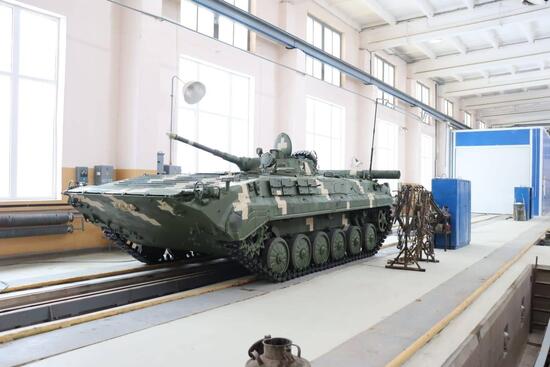
BMP-1 being refurbished by Ukraine.
The equipment of the Ukrainian Marine Corps reflects the style of fighting they want to conduct. A typical mechanized infantry brigade in the Ukrainian army would have: 30 main battle tanks (Such as T-72s), 30 infantry fighting vehicles (usually a tracked IFV such as a BWP-1 or a BMP-1A), and a few dozen armored personnel carriers to ferry the rest of their infantry.
Infantry fighting vehicles differ from armored personnel carriers in that IFVs are meant to carry their infantry units directly into combat and accompany the infantry during the fighting. They are more heavily armored and have 25 mm-40 mm autocannons that can lay down heavy rapid-firing support for infantry units.
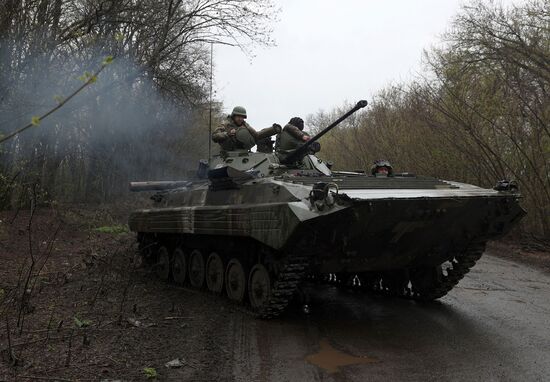
Ukrainian soldiers stand on an armored personnel carrier, not far from the front line with Russian troops, in Izyum, Kharkiv region on April 18, 2022, during the Russian invasion of Ukraine. (Photo by Anatolii Stepanov/AFP)
APCs generally are lightly armed with at most a heavy machine gun and are generally intended to carry infantry close to but not into close-range combat. Their armor is intended to protect infantry from shrapnel and long-range threats. APCs are intended to provide operational mobility, permitting infantry brigades to operate and concentrate larger groups of infantry even within long-range enemy artillery ranges without fear of decimation by shrapnel or cluster munitions. However, the APCs are primarily “battle taxis” that won’t enter combat directly with the infantry it carries.
Ukrainian marines differ greatly from mechanized infantry brigades in that they have a much-reduced tank contingent, having only around 10 tanks per brigade (as opposed to 30), and they have no IFVs. They operate entirely with APCs, mine-resistant ambush-protected vehicles like the MaxxPro armored truck or the Oshkosh M-ATV, and armored infantry mobility vehicles, like HMMWV. In other words, a high proportion of Ukrainian marines travel on armored wheeled vehicles and are trained to fight predominantly on foot in smaller unit actions.
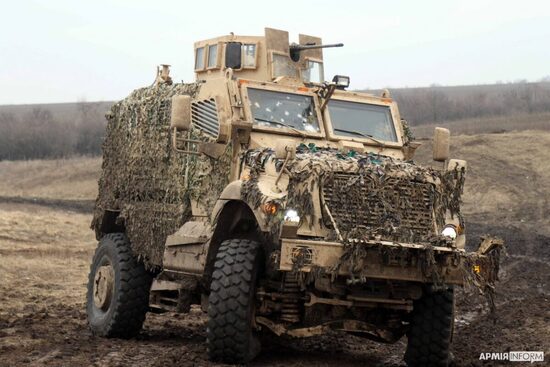
UA MaxxPro of a Jaeger brigade.
This represents a split that exists in many militaries. Some infantry units are built around “heavy infantry” or “armored infantry” concepts, infantry that rides into battle on IFVs. Other infantry units are considered “mechanized light infantry.” Although they ride in and out of battle quickly on armored vehicles that provide them with protection and speed, they fight predominantly on foot.
The Ukrainian Marine Corps can be considered Ukraine’s most powerful group of elite light infantry. They are not well suited for punching through a wall of fortified trench defense line. Breach operations require heavily armored infantry units rolling in armored IFVs like Bradleys and Marders working their way through Russian defenses.
This is reflected in where Ukraine has the choice to deploy the marine corps on a single axis of advance: Velyka Novosilka. Not one, not two, but all four marine brigades have now been deployed on this single axis of advance.
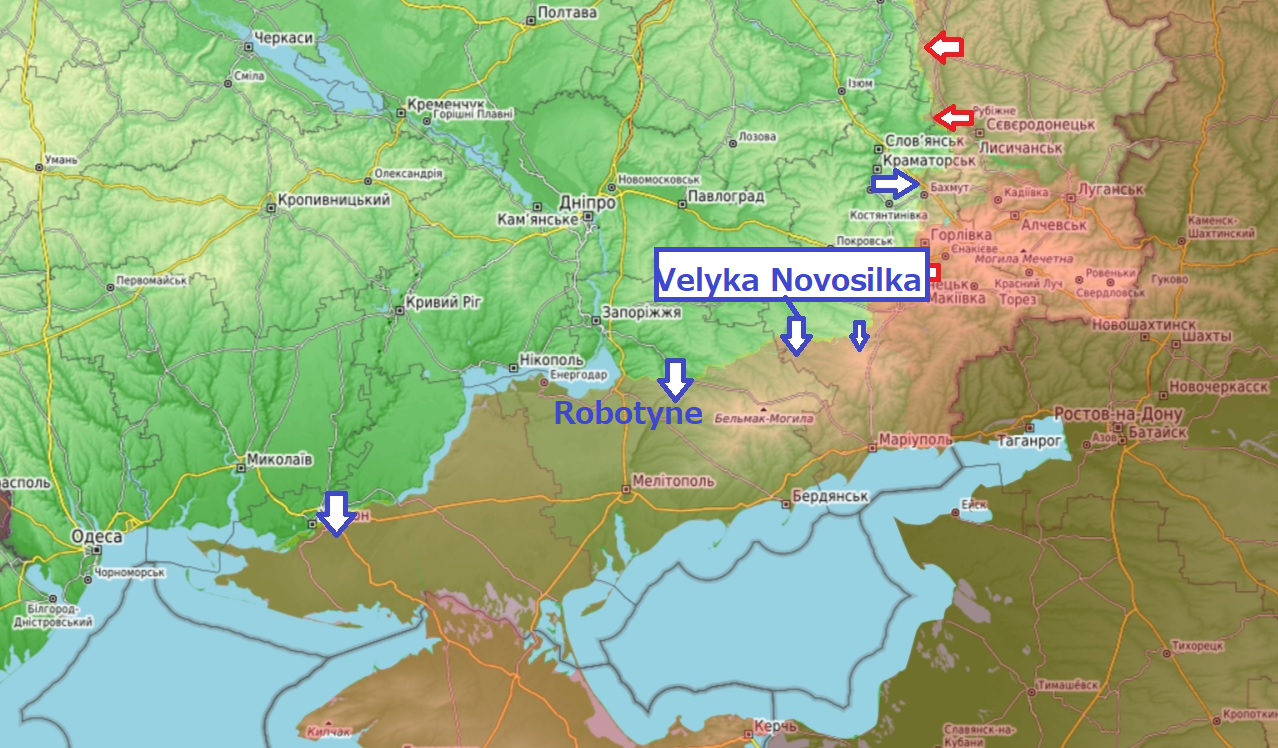
For example, around Robotyne (north of Tokmak), where Russian fortifications and trench works abound, the heavy infantry brigades of the 62nd, 47th, and 33rd Mechanized Brigades are deployed.
In contrast, the farm fields, tree lines, and rolling hills south of Velyka Novosilka are ideal ground for quick-moving marine hit-and-run tactics. Looking closer at this sector, Ukraine’s game plan becomes more apparent.
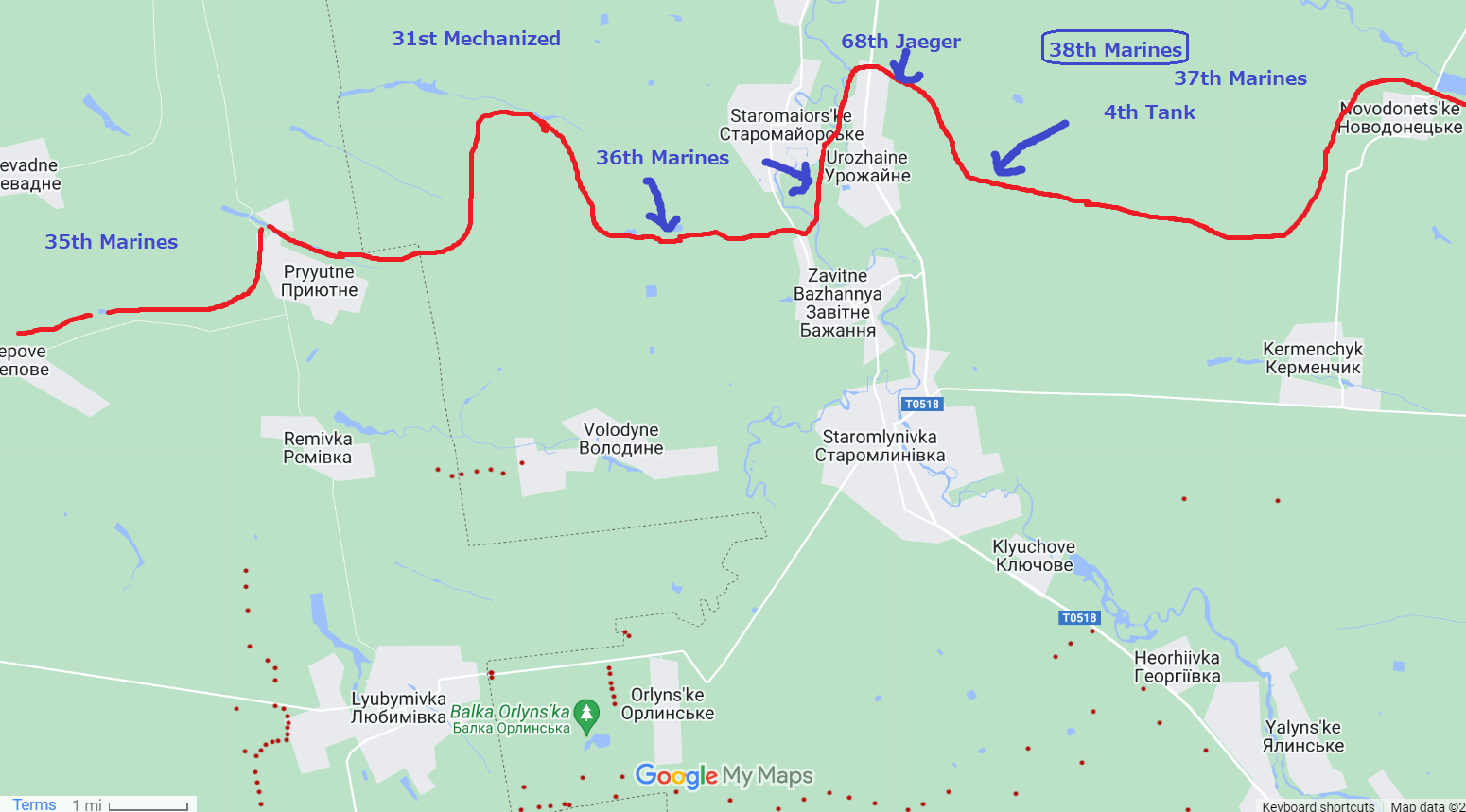
On July 27, a force of Ukrainian troops led by the 36th Marines liberated Staromaiorske, breaching a key position in the Russian lines. From July 29-Aug. 2, Russia launched a series of counterattacks trying to retake Staromaiorske. Several pro-Russian channels repeatedly reported that Ukraine had retreated from Staromaiorske, but after days of Russian counterattacks, Ukraine remained in possession of the city. Despite being effectively surrounded on three sides, Russia has chosen to defend Urozhaine tooth and nail. So for the past week, much of the fighting has focused on the small village of Urozhaine.
Descriptions of Ukrainian marine tactics emphasize the speed and light nature of Ukrainian marine forces. Marines seek to use the mine-protected nature and speed of their MRAPs to bypass and move past Russian strongpoints, deploy then surround, or flank Russian positions in small groups. When successful, they can emulate the U.S. Marines’ thunder run tactics in rapidly bypassing enemy strong points in mechanized column formations, striking deep behind enemy positions to establish disruptive operational gains.
These aggressive tactics are possible, in part, due to the fact the marines travel light, with primarily wheeled armored vehicles, and without waiting for accompanying heavy armored groups that slow their progress. But on the flip side, they tend to be short on anti-tank weaponry and staying power against enemy armor. A late-June assault by the 37th Marines overran several defensive positions and was on the verge of flanking the Russian defenses when a T-72 tank unexpectedly shows up and takes out one of the 37th’s MaxxPro armored trucks. Unprepared at this time for this armored threat, the Ukrainian marines withdrew.
When encountering stiffer Russian resistance, Ukrainian marines will be forced to dismount from their APCs and MRAPs prior to the line of enemy resistance and strike forward more methodically in rapid-forming infantry hit-and-run tactics.
The very fact that the marines rely on cheaper, less valuable armored trucks for transport (as opposed to Bradleys) permits them to be more aggressive and take greater risks. The loss of a MaxxPro truck costs around $300,000, while the loss of a Bradley costs over $3 million. These quick attacks are designed to help reveal enemy strong points or artillery, which permits friendly artillery units to lay down targeted artillery fire. These repeated small-group assaults have kept Ukrainian losses to a minimum while grinding down both Russian artillery and reserve strength in the area.
Indeed, the United Kingdom’s Ministry of Defense intelligence report on July 30 already noted that Russian troops in the area are suffering from severe attrition, morale problems, and artillery shell shortages. And that was before a series of failed counterattacks toward Staromaiorske.
There are some strong signs that these reports are reliable. Pro-Ukrainian sources are reporting a drop in the volume of shellfire from the Russians on this axis. Meanwhile, video footage shows the quality of Russian artillery crews deployed in this area.
For those unable to watch the video, this is a Russian soldier (presumably a conscript) working as part of a mortar team. His job is to drop a mortar round into the tube so the firing pin at the bottom of the tube ignites the propellant on the tail of the mortar round, firing the shell.
There’s just one problem: The fins are facing up, meaning the mortar round is about to slide down the pipe with the warhead sliding directly toward the firing pin. Only the quick intervention of another soldier stops him … but the soldier tries to shove the mortar round down the tube upside down again. He’s stopped a second time, but it shows the remarkably low level of training with which Russian mortar teams are now operating.
In this gradually weakening area of Russian defenses, Ukraine has committed two armored units in this axis of advance, the 32nd Mechanized (a newly formed Soviet-equipped brigade) and the 4th Tank Brigade, an elite veteran outfit. One curious aspect of the 4th Tank Brigade’s involvement is that it was widely reported to have been one of the few Ukrainian brigades to receive Leopard 2 tanks—presumably Leopard 2A4s.
And yet, Ukraine has damaged or lost just six Leopard 2A4s thus far—and none have been geolocated to the Velyka Novosilka area. This is despite the fact the 4th Tank Brigade has been actively fighting in the Velyka Novosilka area since June 12, almost two months ago. The absence of the loss of even a single Leopard 2A4 in this area indicates the 4th Tank Brigade seems to be fighting exclusively with its T-72s and T-64s. The 4th Tank Brigade appears to have thus far kept its Leopard 2A4s in reserve.
RELATED STORY: Quick Explainer: One of Ukraine's Most Elite Units Just Joined the Velyka Novosilka Offensive
Despite promising gains, Ukraine has steadfastly refused to commit its precious heavy armored forces in this area in quantity, and the most powerful armored unit appears to be holding back its most powerful tanks. And Ukraine still has at least five NATO-trained and -equipped heavy armored brigades standing by, including the three most powerful and decorated Ukrainian brigades in the armed forces of Ukraine: the 82nd Air Assault, the 92nd Mechanized, and the 1st Tank Brigade.
All this adds up to a simple conclusion.
RELATED STORY: Quick Explainer: Ukraine's most elite troops are still in reserve
Ukraine appears to want to preserve its armored forces as much as possible until it reaches the first and only major defensive line in this area of the battlefield.
Breaking through that single line of defenses would create a situation ripe for exploitation by fresh armored brigades.
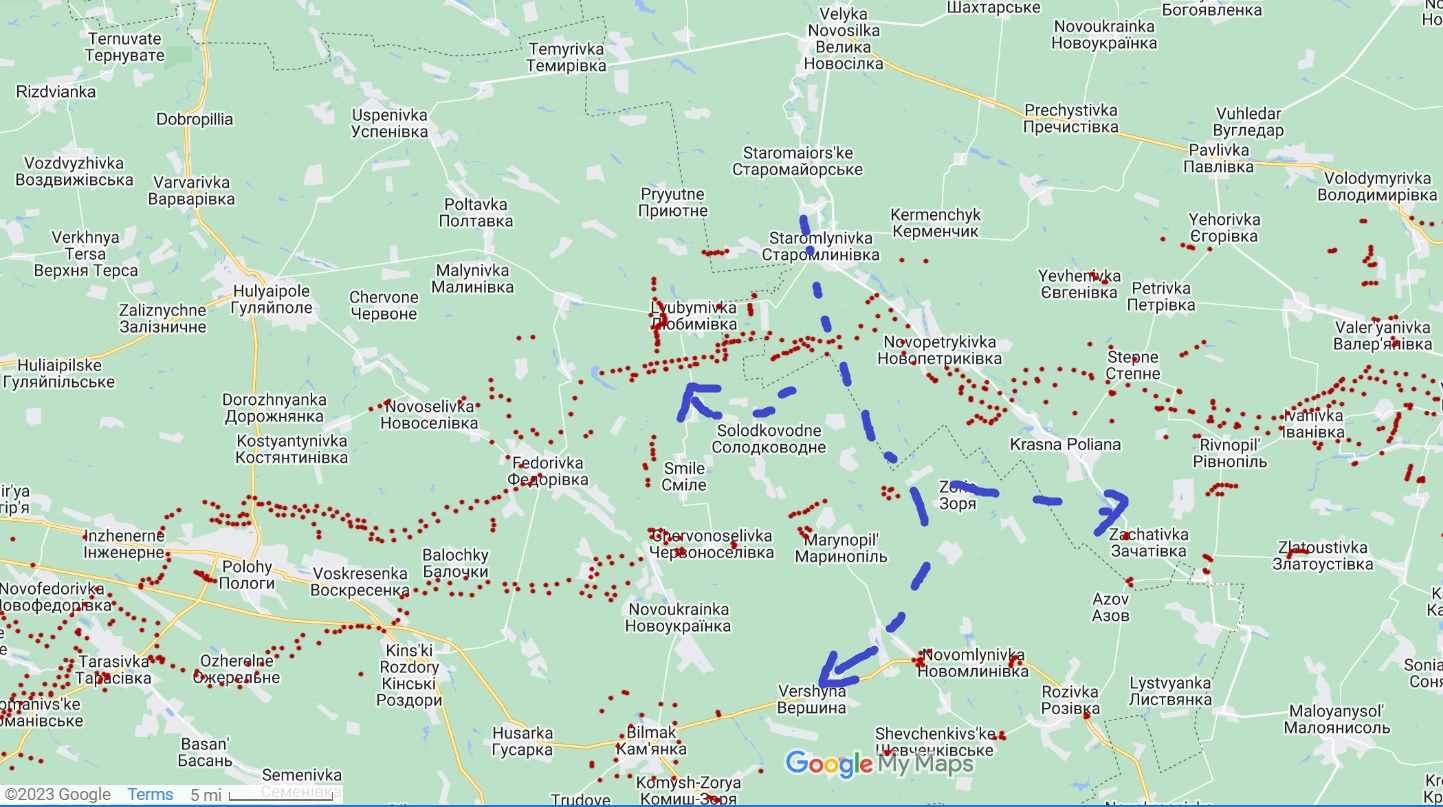
But all of that is predicated on two things:
Ukrainian marines are not heavily armored troops. They are not well suited for overrunning heavily fortified Russian trenches.
Thus, the Ukrainian general staff appears to have calculated that this is the time to use the Ukrainian Marine Corps’ full strength. To destroy Russia’s reserve forces and drive them back through the open ground north of their defensive line, they need to keep Ukraine’s best-armored troops uncommitted and at full strength. The fact that the 4th Tank Brigade has been committed to the fighting for two months yet has saved its best tanks thus far seems extremely deliberate and seems to confirm this approach.
The marines are tantalizingly close to their operation goal: Staromlynivka. Capture Staromlynivka, and the marines will have secured the T0518 highway leading all the way up to the main Russian defense line.
Advance just 5 more miles, around 8 kilometers without needing additional help, and the Ukrainian marines will have cleared the way. The Ukrainian marines will have secured the route for Ukrainian heavy armored forces to take on and break through the main Russian defense line.
Ukraine added new marine brigades in the 36th Brigade (2015), 35th Brigade (2018), and the 38th Brigade, which completed its training in spring 2023. Each composed of around 2,000 soldiers, the Ukrainian marines have some amphibious assault capabilities, but with only a single aging landing ship, the Ukrainian Marine Corps is intended to primarily be elite light infantry.
RELATED STORY: Ukraine Update: China joins 41 other nations working on Ukraine’s peace plan
The Ukrainian marine brigades differ from Ukrainian mechanized infantry in the following ways:
- They are an all-volunteer force of professional soldiers with no conscripts.
- They were formerly under the administration of the navy but were made an independent service branch on May 23, 2023. As a co-equal branch of the armed forces, the marines have their representative on the general staff, alongside the army, navy, and air force.
- They focus on training light infantry actions with a focus on mobility and small unit actions.

BMP-1 being refurbished by Ukraine.
The equipment of the Ukrainian Marine Corps reflects the style of fighting they want to conduct. A typical mechanized infantry brigade in the Ukrainian army would have: 30 main battle tanks (Such as T-72s), 30 infantry fighting vehicles (usually a tracked IFV such as a BWP-1 or a BMP-1A), and a few dozen armored personnel carriers to ferry the rest of their infantry.
Infantry fighting vehicles differ from armored personnel carriers in that IFVs are meant to carry their infantry units directly into combat and accompany the infantry during the fighting. They are more heavily armored and have 25 mm-40 mm autocannons that can lay down heavy rapid-firing support for infantry units.

Ukrainian soldiers stand on an armored personnel carrier, not far from the front line with Russian troops, in Izyum, Kharkiv region on April 18, 2022, during the Russian invasion of Ukraine. (Photo by Anatolii Stepanov/AFP)
APCs generally are lightly armed with at most a heavy machine gun and are generally intended to carry infantry close to but not into close-range combat. Their armor is intended to protect infantry from shrapnel and long-range threats. APCs are intended to provide operational mobility, permitting infantry brigades to operate and concentrate larger groups of infantry even within long-range enemy artillery ranges without fear of decimation by shrapnel or cluster munitions. However, the APCs are primarily “battle taxis” that won’t enter combat directly with the infantry it carries.
Ukrainian marines differ greatly from mechanized infantry brigades in that they have a much-reduced tank contingent, having only around 10 tanks per brigade (as opposed to 30), and they have no IFVs. They operate entirely with APCs, mine-resistant ambush-protected vehicles like the MaxxPro armored truck or the Oshkosh M-ATV, and armored infantry mobility vehicles, like HMMWV. In other words, a high proportion of Ukrainian marines travel on armored wheeled vehicles and are trained to fight predominantly on foot in smaller unit actions.

UA MaxxPro of a Jaeger brigade.
This represents a split that exists in many militaries. Some infantry units are built around “heavy infantry” or “armored infantry” concepts, infantry that rides into battle on IFVs. Other infantry units are considered “mechanized light infantry.” Although they ride in and out of battle quickly on armored vehicles that provide them with protection and speed, they fight predominantly on foot.
The Ukrainian Marine Corps can be considered Ukraine’s most powerful group of elite light infantry. They are not well suited for punching through a wall of fortified trench defense line. Breach operations require heavily armored infantry units rolling in armored IFVs like Bradleys and Marders working their way through Russian defenses.
This is reflected in where Ukraine has the choice to deploy the marine corps on a single axis of advance: Velyka Novosilka. Not one, not two, but all four marine brigades have now been deployed on this single axis of advance.

For example, around Robotyne (north of Tokmak), where Russian fortifications and trench works abound, the heavy infantry brigades of the 62nd, 47th, and 33rd Mechanized Brigades are deployed.
In contrast, the farm fields, tree lines, and rolling hills south of Velyka Novosilka are ideal ground for quick-moving marine hit-and-run tactics. Looking closer at this sector, Ukraine’s game plan becomes more apparent.

On July 27, a force of Ukrainian troops led by the 36th Marines liberated Staromaiorske, breaching a key position in the Russian lines. From July 29-Aug. 2, Russia launched a series of counterattacks trying to retake Staromaiorske. Several pro-Russian channels repeatedly reported that Ukraine had retreated from Staromaiorske, but after days of Russian counterattacks, Ukraine remained in possession of the city. Despite being effectively surrounded on three sides, Russia has chosen to defend Urozhaine tooth and nail. So for the past week, much of the fighting has focused on the small village of Urozhaine.
Descriptions of Ukrainian marine tactics emphasize the speed and light nature of Ukrainian marine forces. Marines seek to use the mine-protected nature and speed of their MRAPs to bypass and move past Russian strongpoints, deploy then surround, or flank Russian positions in small groups. When successful, they can emulate the U.S. Marines’ thunder run tactics in rapidly bypassing enemy strong points in mechanized column formations, striking deep behind enemy positions to establish disruptive operational gains.
These aggressive tactics are possible, in part, due to the fact the marines travel light, with primarily wheeled armored vehicles, and without waiting for accompanying heavy armored groups that slow their progress. But on the flip side, they tend to be short on anti-tank weaponry and staying power against enemy armor. A late-June assault by the 37th Marines overran several defensive positions and was on the verge of flanking the Russian defenses when a T-72 tank unexpectedly shows up and takes out one of the 37th’s MaxxPro armored trucks. Unprepared at this time for this armored threat, the Ukrainian marines withdrew.
When encountering stiffer Russian resistance, Ukrainian marines will be forced to dismount from their APCs and MRAPs prior to the line of enemy resistance and strike forward more methodically in rapid-forming infantry hit-and-run tactics.
The very fact that the marines rely on cheaper, less valuable armored trucks for transport (as opposed to Bradleys) permits them to be more aggressive and take greater risks. The loss of a MaxxPro truck costs around $300,000, while the loss of a Bradley costs over $3 million. These quick attacks are designed to help reveal enemy strong points or artillery, which permits friendly artillery units to lay down targeted artillery fire. These repeated small-group assaults have kept Ukrainian losses to a minimum while grinding down both Russian artillery and reserve strength in the area.
Indeed, the United Kingdom’s Ministry of Defense intelligence report on July 30 already noted that Russian troops in the area are suffering from severe attrition, morale problems, and artillery shell shortages. And that was before a series of failed counterattacks toward Staromaiorske.
There are some strong signs that these reports are reliable. Pro-Ukrainian sources are reporting a drop in the volume of shellfire from the Russians on this axis. Meanwhile, video footage shows the quality of Russian artillery crews deployed in this area.
Russian mortar crew having some very serious training issues. pic.twitter.com/bUUb7BvXpw
— Clash Report (@clashreport) July 13, 2023
For those unable to watch the video, this is a Russian soldier (presumably a conscript) working as part of a mortar team. His job is to drop a mortar round into the tube so the firing pin at the bottom of the tube ignites the propellant on the tail of the mortar round, firing the shell.
There’s just one problem: The fins are facing up, meaning the mortar round is about to slide down the pipe with the warhead sliding directly toward the firing pin. Only the quick intervention of another soldier stops him … but the soldier tries to shove the mortar round down the tube upside down again. He’s stopped a second time, but it shows the remarkably low level of training with which Russian mortar teams are now operating.
In this gradually weakening area of Russian defenses, Ukraine has committed two armored units in this axis of advance, the 32nd Mechanized (a newly formed Soviet-equipped brigade) and the 4th Tank Brigade, an elite veteran outfit. One curious aspect of the 4th Tank Brigade’s involvement is that it was widely reported to have been one of the few Ukrainian brigades to receive Leopard 2 tanks—presumably Leopard 2A4s.
And yet, Ukraine has damaged or lost just six Leopard 2A4s thus far—and none have been geolocated to the Velyka Novosilka area. This is despite the fact the 4th Tank Brigade has been actively fighting in the Velyka Novosilka area since June 12, almost two months ago. The absence of the loss of even a single Leopard 2A4 in this area indicates the 4th Tank Brigade seems to be fighting exclusively with its T-72s and T-64s. The 4th Tank Brigade appears to have thus far kept its Leopard 2A4s in reserve.
RELATED STORY: Quick Explainer: One of Ukraine's Most Elite Units Just Joined the Velyka Novosilka Offensive
Despite promising gains, Ukraine has steadfastly refused to commit its precious heavy armored forces in this area in quantity, and the most powerful armored unit appears to be holding back its most powerful tanks. And Ukraine still has at least five NATO-trained and -equipped heavy armored brigades standing by, including the three most powerful and decorated Ukrainian brigades in the armed forces of Ukraine: the 82nd Air Assault, the 92nd Mechanized, and the 1st Tank Brigade.
All this adds up to a simple conclusion.
RELATED STORY: Quick Explainer: Ukraine's most elite troops are still in reserve
Ukraine appears to want to preserve its armored forces as much as possible until it reaches the first and only major defensive line in this area of the battlefield.
Breaking through that single line of defenses would create a situation ripe for exploitation by fresh armored brigades.

But all of that is predicated on two things:
- Keeping Ukraine’s best-armored forces as fresh and full strength as possible until the critical time.
- Degrading Russian reserves and artillery strength weakened Russia’s ability to resist at the main defensive line.
Ukrainian marines are not heavily armored troops. They are not well suited for overrunning heavily fortified Russian trenches.
Thus, the Ukrainian general staff appears to have calculated that this is the time to use the Ukrainian Marine Corps’ full strength. To destroy Russia’s reserve forces and drive them back through the open ground north of their defensive line, they need to keep Ukraine’s best-armored troops uncommitted and at full strength. The fact that the 4th Tank Brigade has been committed to the fighting for two months yet has saved its best tanks thus far seems extremely deliberate and seems to confirm this approach.
The marines are tantalizingly close to their operation goal: Staromlynivka. Capture Staromlynivka, and the marines will have secured the T0518 highway leading all the way up to the main Russian defense line.
Advance just 5 more miles, around 8 kilometers without needing additional help, and the Ukrainian marines will have cleared the way. The Ukrainian marines will have secured the route for Ukrainian heavy armored forces to take on and break through the main Russian defense line.